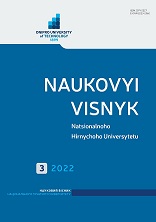

 | Наукова періодика України | 
| Naukovyi visnyk Natsionalnoho Hirnychoho Universytetu |
Koriashkina L. S. On the influence of the number of aggregates and free particles on the subsidence of loess soils / L. S. Koriashkina, T. P. Mokritska, O. V. Bondar, M. M. Odnovol // Науковий вісник Національного гірничого університету. - 2018. - № 5. - С. 5-12. - Режим доступу: http://nbuv.gov.ua/UJRN/Nvngu_2018_5_3 Purpose. Studying connections between microstructure of loess soil and its subsidence on the example of the Pleistocene deposits of the Middle Dnipro river region. Methodology. Experimental and mathematical research methods. The aggregate structure was defined using the improved Ryaschenko's "Microstructure" methodology. Indicators of subsidence were defined according to the current standards of Ukraine. Impact of degradation of microaggregate composition on subsidence was defined with the help of Group method of data handling (GMDH). Findings. Properties of samples of loess-like suppositories, loams and clays, selected from the outcrops within Dnipro and Dnipro region (Vilnohirsk, Kryvyi Rih, Novomykolaiivka village) were studied. The total number of the selected samples is 71. In addition to the methodology for studying granulometric composition of dispersed soils, a way for preparing soil for analysis, which allows clarifying the area of dynamic changes of dispersion, was introduced. The components of the aggregates were predominantly thin-luminescent (in the Dofinivskyi (e PIII df), the Udaiskyi (vd PIII ud), the Dniprovskyi (vd PII dn) horizons) and large-peal particles (the Vitachevskyi horizon e PIII vt), which are released when the aggregates collapse during soil subsidence. There were considered different variants of choosing variables for explaining mathematical model of degradation of loess subsidence in a region of aggregation due to increasing humidity with using Group method of data handling. First of all, standard indicators of dispersion and physical properties of the soil were taken into account. At the next stage, four sets of variables were considered - humidity, the content of individual fractions or changes in the content of fractions after the compression test. It was proven that distribution of free and bound particles, aggregates of sandy, dusty and clay fractions of loess soils of the Middle Dnipro river region together with the indicators of physical state of soil affect the value of relative subsidence of the horizons. Physical state and soil dispersion significantly affect the value of subsidence, regardless of the genesis of the soil. The constructed functional dependency confirms that soil moisture and density have a more significant value than the fraction content. The research results show that the content of bound thin dusty and clay particles is a factor of subsidence on the stage of loss of structural strength (0,1 MPa) and at additional loads. A decrease in the size of released particles with increasing pressure is natural. This pattern is violated in zones of technogenic transformation of the soil structure. Originality. Functional dependence of the subsidence of the Pleistocene loess sediments on the degradation of the microaggregate composition throughout the range of the discreteness of the solid phase was defined. Practical value. Necessity of forecasting the degradation of the subsidence properties of loess-like soils in the aeration zone caused by the change in the microaggregate composition throughout the solid phase range was substantiated experimentally and theoretically. Цитованість авторів публікації: Бібліографічний опис для цитування: Koriashkina L. S. On the influence of the number of aggregates and free particles on the subsidence of loess soils / L. S. Koriashkina, T. P. Mokritska, O. V. Bondar, M. M. Odnovol // Науковий вісник Національного гірничого університету. - 2018. - № 5. - С. 5-12. - Режим доступу: http://nbuv.gov.ua/UJRN/Nvngu_2018_5_3. |
|
|
Всі права захищені © Національна бібліотека України імені В. І. Вернадського |
|||||